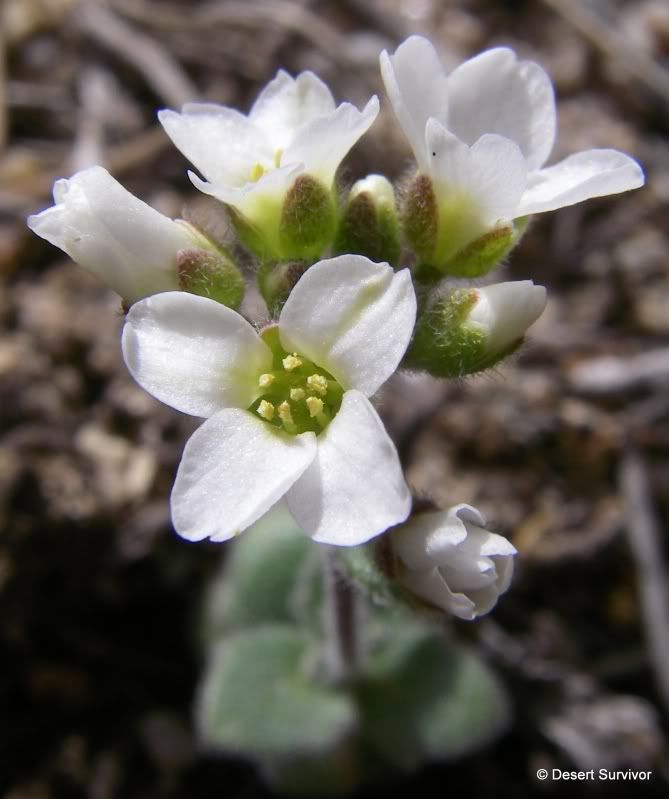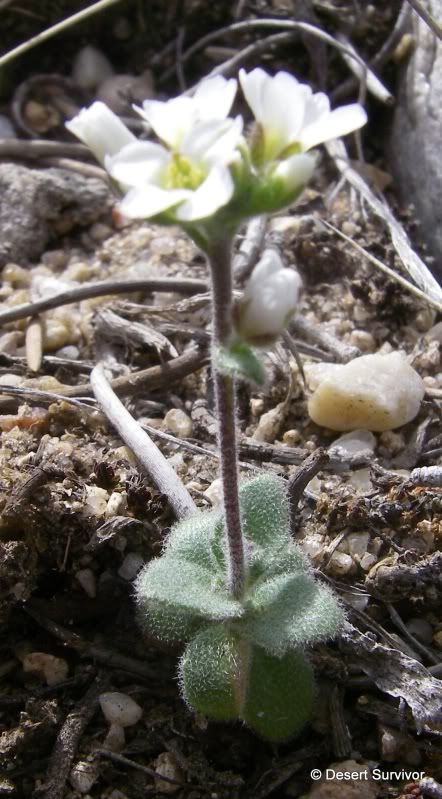Well, this was an unexpected find as I was wandering around the desert this morning. I could tell it was in the Apiaceae family, likely a Cymopterus, but I had never seen one before with such a round, ball-like cluster of flowers. Turns out it's not in the Snake Range flora, so it took a bit of searching to track down as globe springparsley (Cymopterus globosus).
I liked how these plants showed some of the variations in flower (white and pink) and leaf colors (bright green and gray green). This plant only grows in California, Nevada, and Utah, and likes lower elevations. I found these about 5,100 feet elevation.
A closeup of the flowers/seeds reveals cool patterns.
For more info about globe springparsley, click here.
Thursday, April 28, 2011
Wednesday, April 27, 2011
Shockley's Rockcress - Arabis shockleyi

This is a pretty member of the Mustard Family (Brassicaceae), one of the numerous Arabis species. Fortunately, the closely clasping leaves make it rather easy to identify as Shockley's rockcress (Arabis shockleyi). Arabis is undergoing a name change to Boechera, but the USDA Plants Database still has it as Arabis, and for the purposes of this blog, that's my source for official names.

Shockley's rockcress is only found in California, Nevada, and Utah. It grows in pinyon-juniper areas and blooms in April-May.
 For more info about Shockley's rockcress, click here.
For more info about Shockley's rockcress, click here.
Monday, April 25, 2011
Spiny Phlox - Phlox hoodii

This little phlox, growing in mounds out in the sagebrush, was really common at about 6500 feet, yet I've never noticed it until this year! I guess it just goes to show that observing wildflowers can be a long-time passion!
This is spiny phlox (Phlox hoodii), also called carpet phlox by some. It's found throughout most of western North America and can be white or pink. It often blooms right after the snow melts (which is perhaps the reason I haven't seen it before--I was afraid of getting stuck on muddy roads!).

In the photo above, you can see the long corolla tube extending from the pointy, cobwebby leaves. For lots more info about spiny phlox, click here.
p.s. What do you think of this larger photo size on the blog? I've been experimenting and am not sure what I like best yet.
Sunday, April 24, 2011
Wedgeleaf Draba - Draba cuneifolia

When I saw this dainty little flower growing near some rocks on an alluvial fan, I was excited as I knew I hadn't seen it before. The four petals gave me a clue that it was in the mustard family, and it wasn't hard to key out as wedgeleaf draba (Draba cuneifolia).

The basal leaves are quite hairy. Small elliptical seed pods will soon appear. This plant is found throughout much of the U.S.
More info about wedgeleaf draba is found here.
Saturday, April 23, 2011
Spring Flowers
I've been seeing April flowers for a few weeks now, but it's only in the last few days that I've found some that I haven't yet featured on this blog. Before I go into those new species, I thought it might be nice to have a quick review of what's blooming in April in the central Great Basin.
 First up is desert biscuitroot (Lomatium foeniculaceum). It's yellow flowers really stand out. It's cousin Nevada biscuitroot (Lomatium nevadense) with white flowers is really common now.
First up is desert biscuitroot (Lomatium foeniculaceum). It's yellow flowers really stand out. It's cousin Nevada biscuitroot (Lomatium nevadense) with white flowers is really common now.
 I've seen a couple different cryptanthas, including this compact one, James' cryptantha (Cryptantha cinerea).
I've seen a couple different cryptanthas, including this compact one, James' cryptantha (Cryptantha cinerea).
 The Astragalus is really brightening up hillsides. We have 26 different kinds in this area, and I'm struggling with identification (especially since I can't find any photos for a couple of them and am going to have to better my knowledge of the botanical descriptions). I think this is Newberry's milkvetch (Astragalus newberryi).
The Astragalus is really brightening up hillsides. We have 26 different kinds in this area, and I'm struggling with identification (especially since I can't find any photos for a couple of them and am going to have to better my knowledge of the botanical descriptions). I think this is Newberry's milkvetch (Astragalus newberryi).
 A close up of the pretty flower and hairy leaves.
A close up of the pretty flower and hairy leaves.
 A similar looking flower, but with tendrils coming off the leaves is American Vetch (Vicia americana). Amazingly, it's almost done blooming even though it's snowing today.
A similar looking flower, but with tendrils coming off the leaves is American Vetch (Vicia americana). Amazingly, it's almost done blooming even though it's snowing today.
 The yellow round flowers and waxy leaves of creeping barberry (Oregon grape) (Mahonia repens) are dotting the sagebrush areas.
The yellow round flowers and waxy leaves of creeping barberry (Oregon grape) (Mahonia repens) are dotting the sagebrush areas.
 I only saw one longleaf phlox (Phlox longifolia) as I traversed the sagebrush area. Soon there will be a lot more.
I only saw one longleaf phlox (Phlox longifolia) as I traversed the sagebrush area. Soon there will be a lot more.
 The close up revealed the crinkly edges of the petals.
The close up revealed the crinkly edges of the petals.
 There have been lots of non-natives out, like common dandelions (Taraxacum officinale), blue mustard (Chorispora tenella) and the yellow bur buttercup (Ceratocephela testiculata), that makes a nasty little spike as the plant dries out.
There have been lots of non-natives out, like common dandelions (Taraxacum officinale), blue mustard (Chorispora tenella) and the yellow bur buttercup (Ceratocephela testiculata), that makes a nasty little spike as the plant dries out.
 This is a pleasing little plant, Chambers' twinpod (Physaria chambersii). There are several other Physaria species in the area that I need to key out.
This is a pleasing little plant, Chambers' twinpod (Physaria chambersii). There are several other Physaria species in the area that I need to key out.
 A close up of the twinpod.
A close up of the twinpod.
Okay, I've got photos and will start putting up photos (almost) every day beginning next week. I'm looking forward to getting closer to photographing every plant in the Snake Range area flora (see link at top right of page if you want to see the flora).
 First up is desert biscuitroot (Lomatium foeniculaceum). It's yellow flowers really stand out. It's cousin Nevada biscuitroot (Lomatium nevadense) with white flowers is really common now.
First up is desert biscuitroot (Lomatium foeniculaceum). It's yellow flowers really stand out. It's cousin Nevada biscuitroot (Lomatium nevadense) with white flowers is really common now. I've seen a couple different cryptanthas, including this compact one, James' cryptantha (Cryptantha cinerea).
I've seen a couple different cryptanthas, including this compact one, James' cryptantha (Cryptantha cinerea). The Astragalus is really brightening up hillsides. We have 26 different kinds in this area, and I'm struggling with identification (especially since I can't find any photos for a couple of them and am going to have to better my knowledge of the botanical descriptions). I think this is Newberry's milkvetch (Astragalus newberryi).
The Astragalus is really brightening up hillsides. We have 26 different kinds in this area, and I'm struggling with identification (especially since I can't find any photos for a couple of them and am going to have to better my knowledge of the botanical descriptions). I think this is Newberry's milkvetch (Astragalus newberryi). A close up of the pretty flower and hairy leaves.
A close up of the pretty flower and hairy leaves. A similar looking flower, but with tendrils coming off the leaves is American Vetch (Vicia americana). Amazingly, it's almost done blooming even though it's snowing today.
A similar looking flower, but with tendrils coming off the leaves is American Vetch (Vicia americana). Amazingly, it's almost done blooming even though it's snowing today. The yellow round flowers and waxy leaves of creeping barberry (Oregon grape) (Mahonia repens) are dotting the sagebrush areas.
The yellow round flowers and waxy leaves of creeping barberry (Oregon grape) (Mahonia repens) are dotting the sagebrush areas. I only saw one longleaf phlox (Phlox longifolia) as I traversed the sagebrush area. Soon there will be a lot more.
I only saw one longleaf phlox (Phlox longifolia) as I traversed the sagebrush area. Soon there will be a lot more. The close up revealed the crinkly edges of the petals.
The close up revealed the crinkly edges of the petals. There have been lots of non-natives out, like common dandelions (Taraxacum officinale), blue mustard (Chorispora tenella) and the yellow bur buttercup (Ceratocephela testiculata), that makes a nasty little spike as the plant dries out.
There have been lots of non-natives out, like common dandelions (Taraxacum officinale), blue mustard (Chorispora tenella) and the yellow bur buttercup (Ceratocephela testiculata), that makes a nasty little spike as the plant dries out. This is a pleasing little plant, Chambers' twinpod (Physaria chambersii). There are several other Physaria species in the area that I need to key out.
This is a pleasing little plant, Chambers' twinpod (Physaria chambersii). There are several other Physaria species in the area that I need to key out. A close up of the twinpod.
A close up of the twinpod.Okay, I've got photos and will start putting up photos (almost) every day beginning next week. I'm looking forward to getting closer to photographing every plant in the Snake Range area flora (see link at top right of page if you want to see the flora).
Subscribe to:
Posts (Atom)




